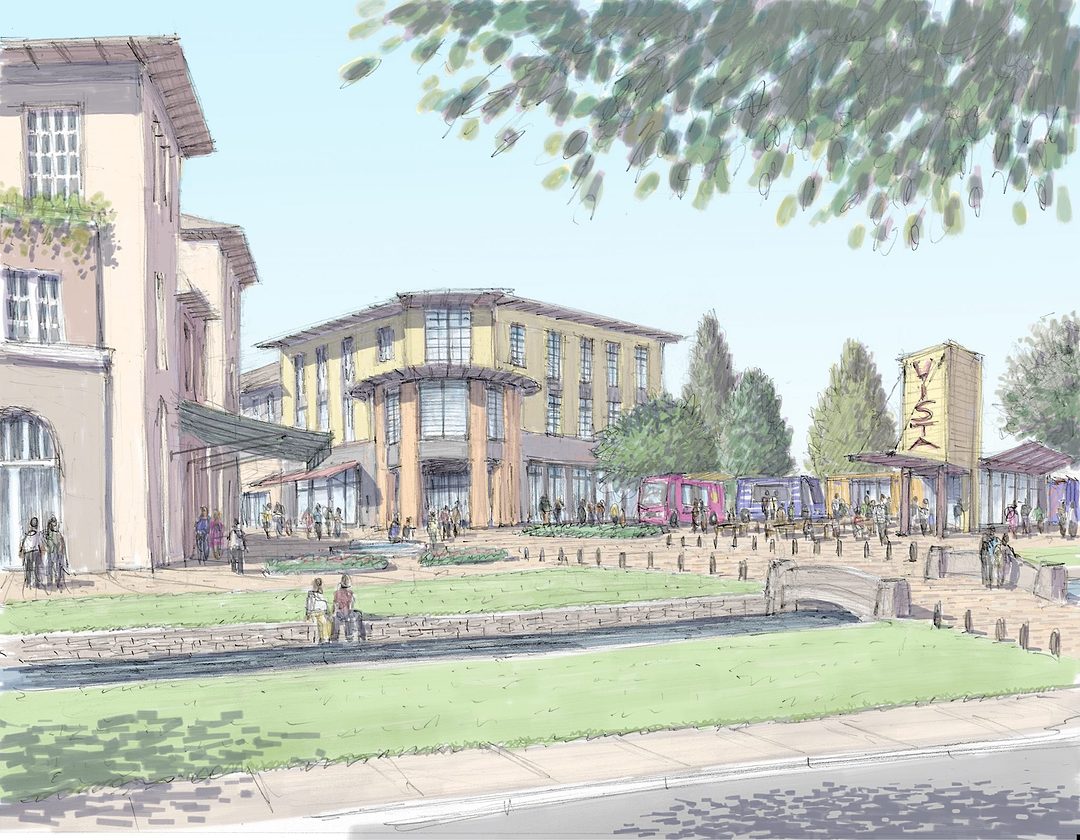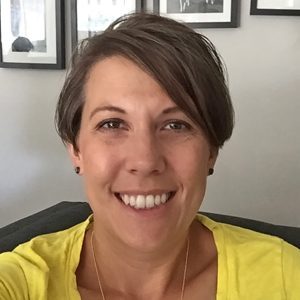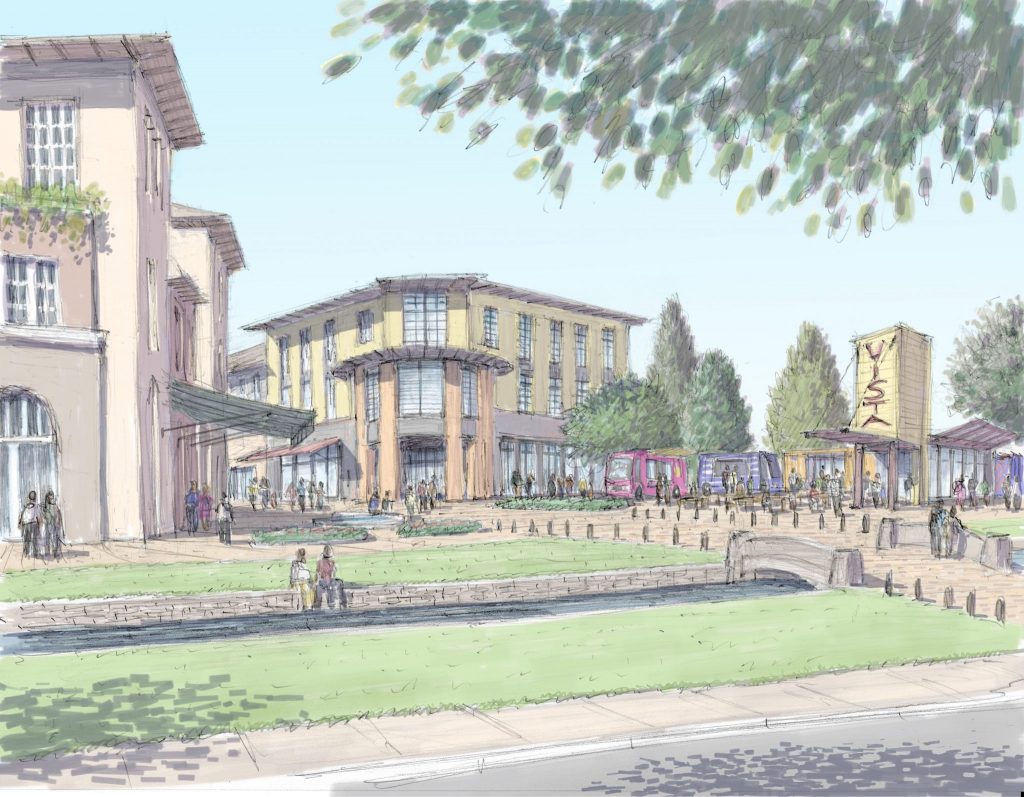
Home » Pedestrian-focused town center coming to Vista Field
Pedestrian-focused town center coming to Vista Field

May 14, 2018
“It’s about to get real.”
That’s what Tim Arntzen, the Port of Kennewick’s chief executive officer, said while describing the next steps for the massive overhaul planned at the former site of Vista Field.
Construction work on the expansive property nestled in the middle of Kennewick is set to kick-start the foundation for vibrant mixed-use streets for walkers, cyclists and cars.
The port recently released conceptual sketches of the “woonerf-inspired” streets. “Woonerf” is a Dutch term often defined as a “living street” in urban planning, meaing traffic is at a minimum and at slow speeds so everything can flow together, whether on foot or wheels.
Homes, businesses and green space will be tied very closely together, sometimes with zero lot lines.
“Vista Field may not be for all,” cautioned Larry Peterson, the port’s director of planning and development. He recognizes the close proximity of neighbors may be appealing to some, but not for those “who want five acres in Badger Canyon, or on a cul-de-sac.”
But that’s decidedly the intent.
The port aims for the new Vista Field to look like nothing else offered in the Tri-Cities.
“There are endless opportunities in the community for 7,200- to 10,000-square-foot lots in the standard subdivision,” Peterson said. “This is intentionally different.”
The maximum lot size for a single owner will be 5,000 square feet. And owners won’t be able to buy multiple lots.
The 103-acre site, behind the Three Rivers Convention Center and Toyota Center, is tucked between North Young and North Kellogg streets. It has remained undeveloped since the airport at Vista Field closed nearly five years ago.
The port plans to put the project to bid in the fall “when the construction companies are hungry and they’re looking for that job to take them through the summer,” said Nick Kooiker, chief financial officer and auditor for the port. “You don’t want to bid things in the summer because most people are working, so we’re going to hit that second window.”
That first phase will include what the port is calling “backbone infrastructure,” including the main street, a couple of the woonerfs, all utilities, landscaping, a water feature, street trees and lights.
“That will enable the port to work with the private sector, and say, ‘Hey we’ve got some great parcels for residential,’ and ‘Hey, we’ve got some great parcels for mixed use,’ ” Kooiker said.
The infrastructure included in the first phase is expected to cost between $5 million and $7 million.
“When it shows what you get for the $5 million to $7 million, I’ve got to be honest, it’s bare bones,” said port Commissioner Thomas Moak.
But Moak is encouraged by the next phase when the private sector starts to build up the streets. “That concept of ‘lean,’ the concept of government doing a small amount and then coming in with the private sector, I think it’s great that we’re living within our means,” he said.
Kooiker expected the port to get a private bank loan of $5 million to cover the initial costs, with the goal of keeping the tax rate at 33 cents per $1,000 of assessed property value.
Kooiker said the port is “determined not to increase that,” even though it has the ability to raise it to 44 cents-per-$1,000.
The port said it is has listened to public feedback in all aspects of the project, from design to financing, and the overriding message was: pay as you go.
Moak insists there will be “no new taxes. We’re not leveraging your future.”
The “pay as you go” approach will be critical for the second phase and beyond, and will allow the port to pay off the loan through land sales and leases, creating more cash to spend on development.
Plans are included in the conceptual sketches rolled out by the port, and designed by Miami-based architecture firm DPZ, which specializes in the concept of new urbanism.
Arntzen said the sketches of walkable streets lined with a bubbling canal, arts center, open pavilion space and retail have all “captured what the public has said through this multi-year process.”
Peterson said, “the primary design element is not automotive-driven.”
The port is looking to offer a solution to what it sees as the “missing middle” in the Tri-Cities — smaller homes and multi-unit apartments.
The end result could include 1,100 residential units and nearly 250,000 square feet of commercial space.
Port Commissioner Don Barnes said the proposal could resolve some of the community concerns outlined in a study by consultant Roger Brooks.
“We lack an urban center, culture and the arts, and small businesses organic to the Tri-Cities. I think that if Vista Field is done well, it will address all the major deficiencies addressed in the Roger Brooks study,” Barnes said.
The Arts Center Task Force, a volunteer nonprofit, has committed to building an 800-seat multi-purpose performing arts center at Vista Field.
The Vista Arts Center will be funded through donations and grants.
Planners are excited about creating a “vibrant center of the Tri-Cities,” Moak said. He believes people will “expect vibrancy” if they choose to live at Vista Field to road test this new concept.
“The sidewalks don’t roll up at 5 o’clock when the stores close,” Peterson said.
“You’ll be able to live, work and play all in one area to make better use of the spaces,” Barnes said.
The project will be years in the making. It will be built in eight phases, from the center out, targeting no more than 20 acres in a single phase so it could take a long time to fully reach its potential.
At full build-out, the project will bring in nearly $500 million in private investments.
“I may not see the promised land. But it will be there for a lot of folks who are going to come after us,” Moak said. “We hope to be able, as a port, to shepherd one of the greatest developments in the history of the Tri-Cities.”
The plans are to break ground on the first phase later this year with completion by July 2019.
Moak invites the public to remain a vocal part of the planning the build-out process: “We need you to continue to hold us true to the vision, to continue to ask the tough questions, to make sure we have that livable, bikeable, walkable community of vibrancy that you’ve asked for.”
Real Estate & Construction Local News
KEYWORDS may 2018






